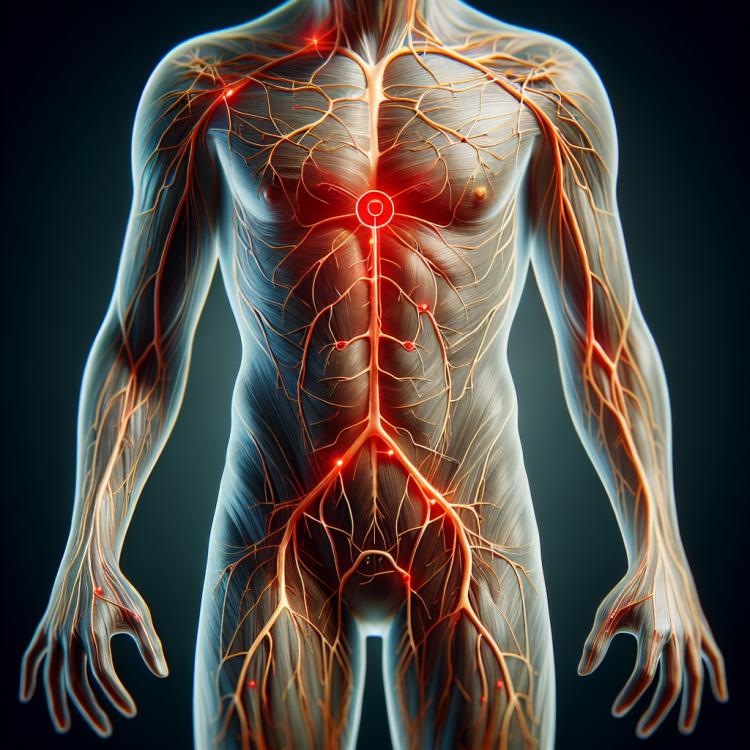
Nerve damage: diagnosis, treatment, and rehabilitation
What is Nerve Damage: Causes and Consequences
Nerve damage, or nerve injury, is a condition in which nerve fibers are subjected to damage, which can lead to disruption of signal transmission along the nerve. Causes of nerve damage can include trauma, compression, mechanical pressure, surgical procedures, or diseases that affect nerve structures. Nerve damage can cause various consequences such as loss of sensation, changes in motor functions, numbness, or pain in the area innervated by the affected nerve. Recovery of nerve function may require comprehensive treatment, including physical therapy, surgical intervention, and rehabilitation measures.
Causes of Nerve Damage
Nerve damage can be caused by various factors, including injuries, surgical interventions, prolonged pressure on the nerves, infections, or degenerative processes. Injuries, such as bone fractures or joint sprains, can lead to compression or rupture of nerves. Surgical operations can also damage nerves due to the mechanical action of instruments or changes in surrounding tissues.
Other causes of nerve damage may include nerve compression due to the formation of neoplasms or tumors, neuropathy in diabetes, autoimmune diseases, inflammatory processes, or circulatory disorders. These diverse causes can lead to disruption of normal nervous system function, manifesting in a variety of clinical symptoms and diagnostic signs.
- Injuries: Bone fractures, joint sprains, or other traumatic injuries can lead to compression or tearing of nerves.
- Surgical interventions: Surgical procedures can damage nerves due to the action of instruments or changes in surrounding tissues.
- Neoplasms and tumors: Neoplasms or tumors can compress nerve structures, leading to damage.
- Diabetic neuropathies: Diabetic neuropathy can cause nerve damage due to high blood sugar levels.
- Autoimmune diseases: They can attack nerve structures, causing damage and dysfunction.
Symptoms of nerve damage
Nerve damage can manifest various symptoms, depending on the location of the injury and the extent of damage. Among the most common symptoms are numbness, tingling, weakness, or loss of sensation in the area innervated by the affected nerve. This may be accompanied by pain of varying intensity, as well as impaired motor function in the affected area.
Other typical symptoms of nerve damage include changes in sensory or motor function, possible changes in the skin covering certain areas of the body, and autonomic function disorders, such as changes in sweating or skin temperature. If such symptoms appear, it is important to seek medical attention immediately for diagnosis and appropriate treatment.
- Numbness and tingling: Nerve damage is often accompanied by a feeling of numbness or tingling in the affected area.
- Muscle weakness: Loss of normal motor function by the nerves may manifest as muscle weakness in the corresponding part of the body.
- Loss of sensitivity: Nerve damage can cause loss or alteration of sensitivity in the area of innervation.
- Pain sensations: Pain of varying intensity may occur in the area of the damaged nerve.
- Changes in the skin: Nerve damage can also cause changes in the condition of the skin in the affected area.
Expert opinions on treating nerve damage
The experts’ opinion on the treatment of nerve damage is based on a comprehensive approach aimed at restoring the normal function of the affected nerves. Experts recommend an individualized approach to treatment, taking into account the specifics of each case, including the mechanism of injury, the degree of damage, and the overall condition of the patient. Medication therapy, physiotherapy, surgical intervention, rehabilitation, and other methods may be applied depending on the clinical picture.
Significant attention is also paid to early diagnosis and prevention of nerve damage, which allows for timely treatment to prevent potential complications. Experts emphasize the importance of a multimodal approach to treatment, which combines various methods for the most effective restoration of nerve function and improvement of the patient’s quality of life.

Nerve Damage Diagnosis
The diagnosis of nerve damage involves various examination methods aimed at determining the location and nature of the damage. Clinical examination may suggest the presence of neurological deficits, such as loss of sensation, weakness, or impaired motor function in the area innervated by the affected nerve. Additional instrumental and laboratory methods, such as electromyography, neuroimaging, or biochemical analyses, may be used for a more precise determination of the mechanism of damage and the area affected.
An important step in diagnosing nerve damage is establishing an accurate diagnosis, which will help determine the optimal treatment methods. Professional neurological examination and the comprehensive use of modern diagnostic methods allow for effective identification of the nature and extent of nerve damage, which is a crucial step towards successful treatment.
- Clinical examination: A neurological examination allows for the identification of neurological deficits, such as loss of sensation, weakness, or motor function disorders.
- Electromyography: A method that allows assessment of the electrical activity of muscles and nerves to determine the affected areas.
- Neuroimaging: Instrumental studies, such as MRI or CT, can be used to visualize nerves and determine the nature of the damage.
- Biochemical tests: Laboratory studies may include blood tests to identify markers reflecting the presence of inflammation or other processes related to nerve damage.
- Neuropathological examination: A neuropathologist may conduct specialized tests, such as sensitivity tests or reflexes, for additional diagnosis of nerve damage.
Nerve injury treatment
In more serious cases, where conservative methods do not yield the desired effect, surgical intervention may be necessary. Surgical treatment may include the reconstruction of the damaged nerve, nerve grafting, or other methods to restore nerve functionality. It is important to take an individual approach to the choice of treatment method in each specific case to ensure the best outcome and restoration of nerve function.
- Physical therapy and rehabilitation: Physical therapy can help restore nerve function through special exercises and procedures.
- Medication treatment: The use of medications can improve control over pain, inflammation, and other symptoms of nerve damage.
- Nerve block injections: Injections may be used to relieve pain symptoms and improve the function of the affected nerve.
- Surgical treatment: In cases of severe damage, surgical intervention may be required to restore the structure and function of the nerves.
- Nerve transplantation: If necessary, nerve transplantation may be performed to restore impulse transmission in the damaged area.
Prevention of nerve damage
Regular exercises to strengthen muscles and joints, proper posture while working on a computer or performing everyday tasks, as well as timely consultation with a doctor at the first signs of nerve dysfunction also contribute to the prevention of nerve damage. Early detection of pathologies and timely treatment can help prevent serious complications and keep the nervous system in a healthy state.
- Avoid monotonous movements and prolonged pressure: repetitive uniform movements and prolonged sitting or standing in one position can cause nerve compression.
- Follow safety rules when exercising: when engaging in sports, protective gear should be used to prevent injuries that could damage nerves.
- Strengthen muscles and joints: regular exercises to strengthen muscles and joints can help reduce the risk of nerve damage due to improper loads.
- Maintain proper body position: proper ergonomics when working on a computer or performing daily tasks will help avoid excessive pressure on nerve structures.
- Consult a doctor at the first signs of neurological disorders: timely detection and treatment of initial signs of nerve dysfunction can help prevent the development of serious complications.
Interesting facts about nerve damage
Another interesting aspect is that nerves are capable of adaptation and functional transfer in case of damage. This process is called neuroplasticity and allows the nervous system to adapt to changes in the external environment or the internal states of the body. Understanding these features of the nervous system’s functioning is crucial for further research and the development of methods for treating nerve injuries.